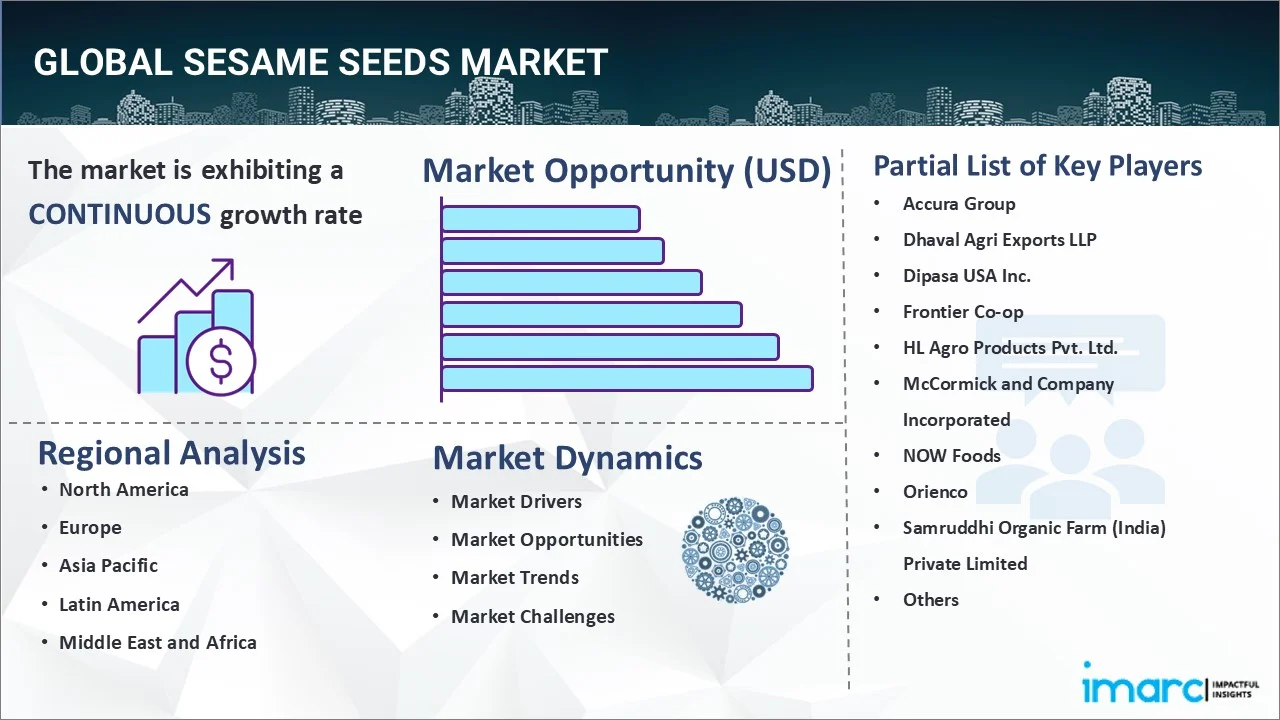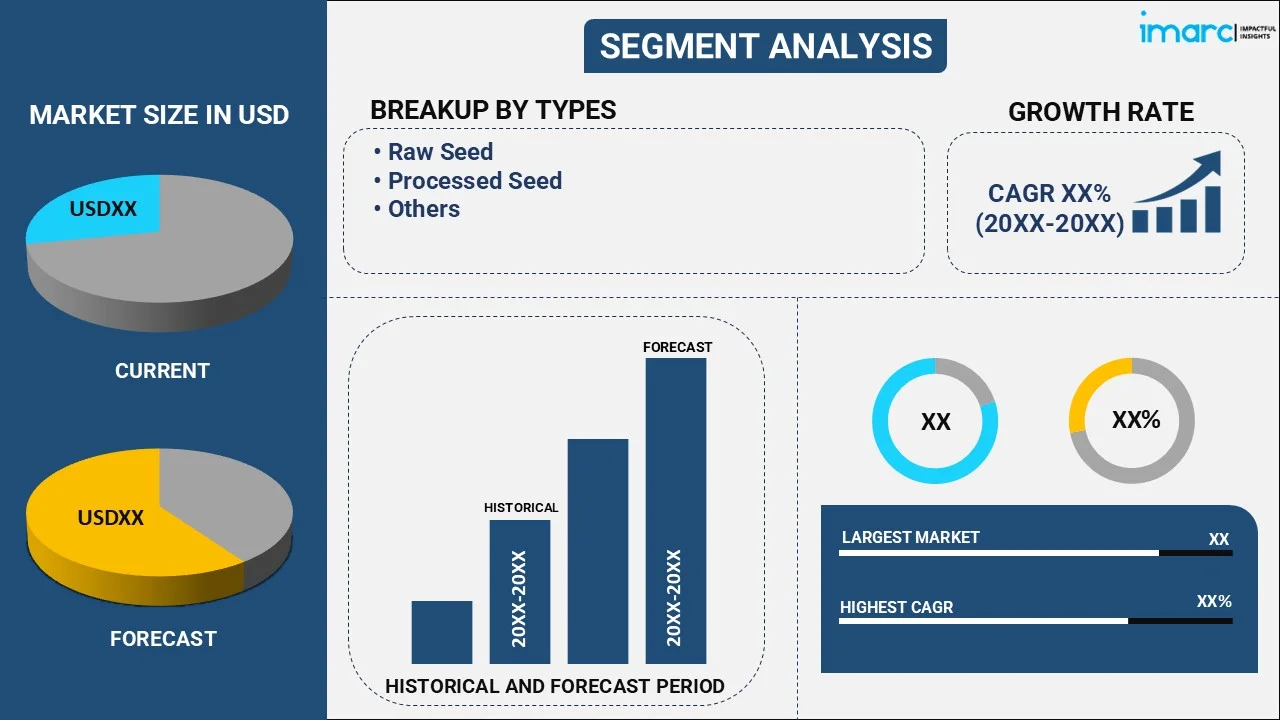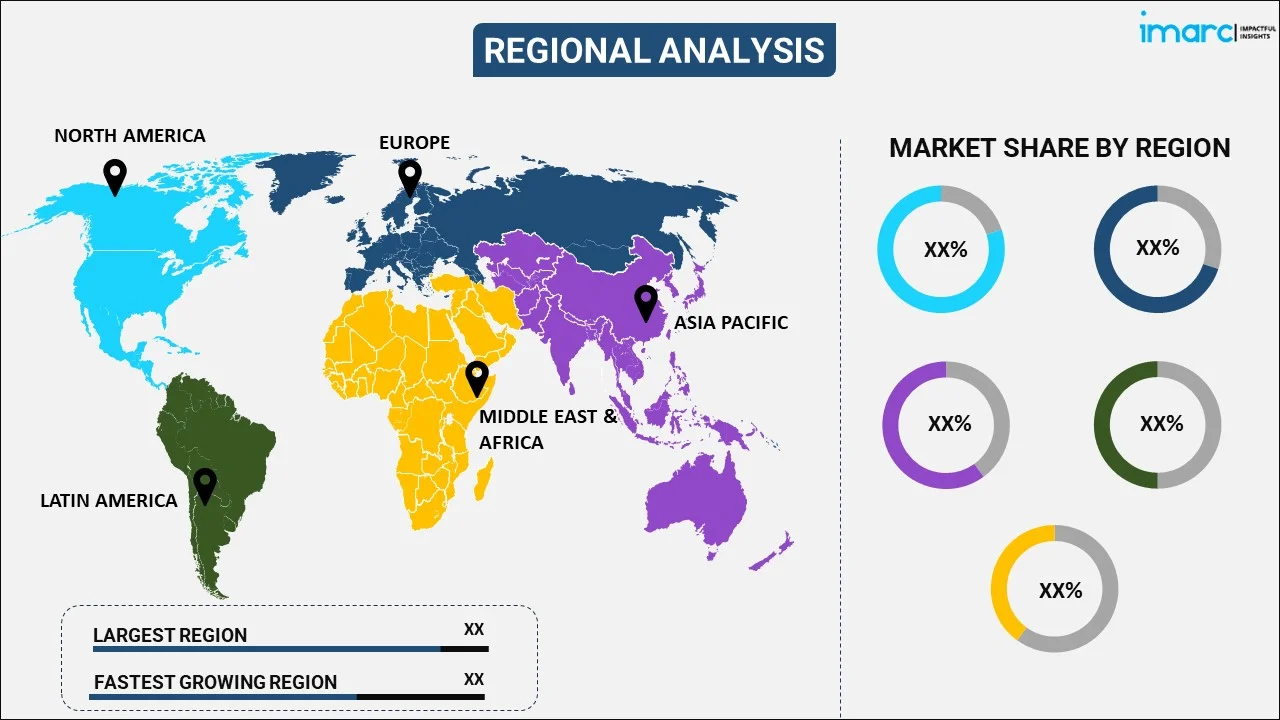
Sesame Seeds Market Report by Type (Raw Seed, Processed Seed, and Others), Color (White, Black, Brown, and Others), Category (Organic, Conventional), Application (Food and Beverages, Cosmetics, and Others), Distribution Channel (Online, Offline), and Region 2025-2033
Market Overview:
The global sesame seeds market size reached USD 7.4 Billion in 2024. Looking forward, IMARC Group expects the market to reach USD 9.0 Billion by 2033, exhibiting a growth rate (CAGR) of 2.16% during 2025-2033. The increasing demand for healthy foods, the growing awareness regarding the nutritional benefits of sesame seeds and the growing popularity of ethnic cuisines represent some of the key factors driving the market.
|
Report Attribute
|
Key Statistics
|
|---|---|
|
Base Year
|
2024 |
|
Forecast Years
|
2025-2033
|
|
Historical Years
|
2019-2024
|
| Market Size in 2024 | USD 7.4 Billion |
| Market Forecast in 2033 | USD 9.0 Billion |
| Market Growth Rate (2025-2033) | 2.16% |
Sesame seeds are the small, flat seeds of the Sesamum indicum plant, which is native to Africa and Asia. These seeds have a nutty and slightly sweet flavor and are commonly used in cooking, particularly in Middle Eastern, Asian, and Mediterranean cuisines. They come in a range of colors, from pale yellow to black, and can be either hulled or unhulled. Hulled sesame seeds are the most commonly used for culinary purposes, as they have a softer texture and a more delicate flavor. Unhulled sesame seeds have a coarse texture and a stronger flavor and are often used in health foods because they contain more fiber and nutrients than hulled seeds. In addition, sesame seeds are a rich source of protein, healthy fats, and minerals such as calcium, magnesium, and iron. They are also used to make tahini, a paste that is a staple ingredient in many dishes, including hummus and baba ghanoush. Sesame oil is another popular product that is made from sesame seeds and is commonly used in cooking and as a condiment. As a result, sesame seeds are widely utilized in the food and beverage (F&B) industry across the globe.

Sesame Seeds Market Trends:
The market is primarily driven by the increasing demand for healthy foods across the globe. Sesame seeds are a rich source of nutrients, including protein, healthy fats, and minerals, making them a popular ingredient in health food products. The growing trend of health and wellness among consumers is driving the demand for sesame seeds as a healthy ingredient in various food products. In addition, the emerging popularity of ethnic cuisines represents another major growth-inducing factor. Sesame seeds are a staple ingredient in many Asian and Middle Eastern cuisines, such as hummus, tahini, and sesame oil. Besides this, the demand for convenience foods is increasing due to the busy lifestyles of consumers. Sesame seeds are used as an ingredient in various convenience food products such as snack bars, energy bars, and bakery products. This, coupled with the growing awareness among individuals regarding the nutritional benefits of sesame seeds, is positively influencing the market growth. Sesame seeds are a rich source of protein, healthy fats, and minerals such as calcium, magnesium, and iron, making them an attractive ingredient for health-conscious consumers. Moreover, the increasing prevalence of chronic diseases, rising disposable incomes, and the growing product utilization as an antioxidant source in various pharmaceutical formulations are other factors creating a positive market outlook across the globe.
Key Market Segmentation:
IMARC Group provides an analysis of the key trends in each segment of the global sesame seeds market, along with forecasts at the global, regional, and country levels from 2025-2033. Our report has categorized the market based on type, color, category, application, and distribution channel.
Type Insights:

- Raw Seed
- Processed Seed
- Others
The report has provided a detailed breakup and analysis of the sesame seeds market based on the type. This includes raw seed, processed seed, and others.
Color Insights:
- White
- Black
- Brown
- Others
A detailed breakup and analysis of the sesame seeds market based on the color has also been provided in the report. This includes white, black, brown, and others. According to the report, white accounted for the largest market share.
Category Insights:
- Organic
- Conventional
The report has provided a detailed breakup and analysis of the sesame seeds market based on the category. This includes organic and conventional. According to the report, organic represented the largest segment.
Application Insights:
- Food and Beverages
- Cosmetics
- Others
A detailed breakup and analysis of the sesame seeds market based on the application has also been provided in the report. This includes food and beverage, cosmetics, and others. According to the report, food and beverage accounted for the largest market share.
Distribution Channel Insights:
- Online
- Offline
The report has provided a detailed breakup and analysis of the sesame seeds market based on the distribution channel. This includes online and offline.
Regional Insights:

- North America
- United States
- Canada
- Europe
- Germany
- France
- United Kingdom
- Italy
- Spain
- Russia
- Others
- Asia Pacific
- China
- Japan
- India
- South Korea
- Australia
- Indonesia
- Others
- Latin America
- Brazil
- Mexico
- Others
- Middle East and Africa
The report has also provided a comprehensive analysis of all the major regional markets, which include North America (the United States and Canada); Europe (Germany, France, the United Kingdom, Italy, Spain, Russia, and others); Asia Pacific (China, Japan, India, South Korea, Australia, Indonesia, and others); Latin America (Brazil, Mexico, and others); and the Middle East and Africa. According to the report, Asia Pacific was the largest market for sesame seeds. Some of the factors driving the Asia Pacific sesame seeds market included growing health awareness among individuals, the emerging popularity of ethnic cuisines, and rising product adoption in convenience foods.
Competitive Landscape:
The report has also provided a comprehensive analysis of the competitive landscape in the global sesame seeds market. Detailed profiles of all major companies have also been provided. Some of the companies covered include Accura Group, Dhaval Agri Exports LLP, Dipasa USA Inc., Frontier Co-op, HL Agro Products Pvt. Ltd., McCormick and Company Incorporated, NOW Foods, Orienco, Samruddhi Organic Farm (India) Private Limited, Shyam Industries, Tradin Organic Agriculture B.V, Unicorn Ingredients Limited, Virdhara International, Wholefood Earth LTD, etc. Kindly note that this only represents a partial list of companies, and the complete list has been provided in the report.
Report Coverage:
| Report Features | Details |
|---|---|
| Base Year of the Analysis | 2024 |
| Historical Period | 2019-2024 |
| Forecast Period | 2025-2033 |
| Units | Billion USD |
| Types Covered | Raw Seed, Processed Seed, Others |
| Colors Covered | White, Black, Brown, Others |
| Categories Covered | Organic, Conventional |
| Applications Covered | Food and Beverages, Cosmetics, Others |
| Distribution Channels Covered | Online, Offline |
| Regions Covered | Asia Pacific, Europe, North America, Latin America, Middle East and Africa |
| Countries Covered | United States, Canada, Germany, France, United Kingdom, Italy, Spain, Russia, China, Japan, India, South Korea, Australia, Indonesia, Brazil, Mexico |
| Companies Covered | Accura Group, Dhaval Agri Exports LLP, Dipasa USA Inc., Frontier Co-op, HL Agro Products Pvt. Ltd., McCormick and Company Incorporated, NOW Foods, Orienco, Samruddhi Organic Farm (India) Private Limited, Shyam Industries, Tradin Organic Agriculture B.V, Unicorn Ingredients Limited, Virdhara International, Wholefood Earth LTD, etc. |
| Customization Scope | 10% Free Customization |
| Post-Sale Analyst Support | 10-12 Weeks |
| Delivery Format | PDF and Excel through Email (We can also provide the editable version of the report in PPT/Word format on special request) |
Key Benefits for Stakeholders:
- IMARC’s report offers a comprehensive quantitative analysis of various market segments, historical and current market trends, market forecasts, and dynamics of the sesame seeds market from 2019-2033.
- The research study provides the latest information on the market drivers, challenges, and opportunities in the global sesame seeds market.
- The study maps the leading, as well as the fastest-growing, regional markets. It further enables stakeholders to identify the key country-level markets within each region.
- Porter's five forces analysis assist stakeholders in assessing the impact of new entrants, competitive rivalry, supplier power, buyer power, and the threat of substitution. It helps stakeholders to analyze the level of competition within the sesame seeds industry and its attractiveness.
- Competitive landscape allows stakeholders to understand their competitive environment and provides an insight into the current positions of key players in the market.
Key Questions Answered in This Report
The global sesame seeds market was valued at USD 7.4 Billion in 2024.
We expect the global sesame seeds market to exhibit a CAGR of 2.16% during 2025-2033.
The rising popularity of ethnic cuisines, along with the increasing demand for sesame seeds, as they offer a rich source of protein, healthy fats, and minerals, such as calcium, magnesium, iron, etc., is primarily driving the global sesame seeds market.
The sudden outbreak of the COVID-19 pandemic has led to the changing consumer inclination from conventional brick-and-mortar distribution channels towards online retail platforms for the purchase of sesame seeds.
Based on the color, the global sesame seeds market can be segmented into white, black, brown, and others. Currently, white holds the majority of the total market share.
Based on the category, the global sesame seeds market has been divided into organic and conventional, where organic currently exhibits a clear dominance in the market.
Based on the application, the global sesame seeds market can be categorized into food and beverages, cosmetics, and others. Currently, food and beverages account for the largest market share.
On a regional level, the market has been classified into North America, Europe, Asia Pacific, Latin America, and Middle East and Africa, where Asia Pacific currently dominates the global market.
Some of the major players in the global sesame seeds market include Accura Group, Dhaval Agri Exports LLP, Dipasa USA Inc., Frontier Co-op, HL Agro Products Pvt. Ltd., McCormick and Company Incorporated, NOW Foods, Orienco, Samruddhi Organic Farm (India) Private Limited, Shyam Industries, Tradin Organic Agriculture B.V, Unicorn Ingredients Limited, Virdhara International, Wholefood Earth LTD, etc.
Need more help?
- Speak to our experienced analysts for insights on the current market scenarios.
- Include additional segments and countries to customize the report as per your requirement.
- Gain an unparalleled competitive advantage in your domain by understanding how to utilize the report and positively impacting your operations and revenue.
- For further assistance, please connect with our analysts.
 Inquire Before Buying
Inquire Before Buying
 Speak to an Analyst
Speak to an Analyst
 Request Brochure
Request Brochure
 Request Customization
Request Customization




.webp)




.webp)












